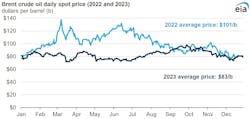At first glance, it looks like manufacturing had an awful year in 2023. Despite a more stable supply chain, slower inflation growth and record consumer spending, the 500 largest manufacturers in the U.S. posted sales and profit declines for the year.
It comes down to oil and gas.
In 2022, surging oil prices led to record revenues and profits for ExxonMobil, Chevron and other energy giants. Last year, as oil prices calmed down a bit, revenues fell and profit margins eased—great news for anyone filling up at the pump, not such great news when you’re looking at aggregate numbers for the manufacturing sector.
Sector Strengths & Weaknesses
Manufacturing encompasses a diverse set of products and markets, something that has always haunted the IW U.S. 500. Throughout the past two years, we’ve taken a labor-intensive approach to removing non-manufacturing companies from the tally, but we’re still left with comparing Utz snack foods to ExxonMobil’s chemicals and refining businesses.
Looking back at 2024, a sector-by-sector breakdown shows that the largest sectors in manufacturing were fairly stable last year, but the sectors that declined posted big changes.
Put simply, oil prices were down 18% last year, and natural gas prices fell 62%. Energy company revenues on the IW U.S. 500 fell 14%.
One interesting note from the 2023 list—although oil producers were generally up, the companies making oilfield equipment struggled. Baker Hughes lost $600 million, NOV Inc. posted a 2.1% profit margin, ChampionX Corp. had a 4% margin. But, in 2024, Baker Hughes’ revenues were up 21%, and it posted a $1.9 billion profit. NOV and Haliburton also grew sales in the double digits.
Information Technology: 10.4% Profit Margin, Down from 12.6%
The supply chain crunch of 2021 and 2022 drove home the importance of semiconductors to nearly everyone in the world, and it led to massive increased in production into 2023 – likely too much production. Chip shortages turned into chip gluts in some sectors, hammering the biggest tech companies in the world in 2023, most notably chip makers such as Intel and Micron.
Intel fell to No. 25 in 2024 from No. 19 in 2023 as revenues declined 14%. Micron dove from No. 46 to No. 92 as revenues plunged nearly in half.
The carnage wasn’t universal. Chipmakers Qualcomm and Broadcom both grew sales and profitability, and IBM’s sales were up slightly.
The Rest: 8.1% Profit Margin, Up from 7.8%
Automakers, food producers and traditional industrial companies had a better year than their counterparts on the list, posting increases to sales, profits and profit margins. However, gains were in the low single digits, so they didn’t come close to offsetting reduced sales and profitability of tech, healthcare and energy producers.
Despite some high-profile challenges with electric vehicles, Ford and General Motors pushed their way back into the Top 5 of the 2024 list with revenue gains of 11.5% and 9.6% respectively. And, Tesla joined the Top 10, coming in at No. 8 in 2024 after placing No. 13 last year. Tesla recently posted poor first-quarter 2024 results, but its 19% sales gain last year, coupled with a 15.5% profit margin, was an impressive performance.
Speaking of electric vehicles, automakers fall into the broader consumer discretionary economic category, a sector that rarely posts stellar profit margins. As a group, it hit 4.6% for the 2024 IW U.S. 500. The category would have been nearly a full percentage point higher (5.4%) had it not been for one EV startup – Rivian. The producer of electric vans for Amazon and pickups for consumers lost $5.4 billion last year, despite growing sales by 167%. That’s the nature of startups – lots of cash burned before the profits can start.
Consumer staples companies that produce food, toothpaste, cleaning supplies and other items that people continue to buy, despite overall economic conditions, performed solidly, gaining 2% in sales and posting a 10.5% profit margin.
Remember last year’s skyrocketing egg prices, spurred by avian flu forcing farms to slaughter millions of laying hens? That shows up in the IW U.S. 500 with Cal-Maine Foods, a Mississippi company that sells lots of eggs. As prices spiked, Cal-Maine’s revenues jumped 77% and net income spiked nearly six-fold ($758 million in 2023 earnings vs. $132.7 million in 2022).
The final sector in the Others category are the industrials – typically B2B companies such as Cummins, Illinois Tool Works and Emerson Electric. With sales up nearly 9% and a stable profit margin (8.4% in 2024 vs. 8.2% in 2023), the group looks like it had a solid if not terribly exciting 2023. Some of these firms’ end markets (electrical equipment, for instance) are doing great while others have been rather limping along.
But, the big iron companies, the ones producing giant industrial equipment, performed better than the overall group with Caterpillar Inc. and Deere & Co. both posting solid, double-digit sales gains and strong margins.
The laggard for the group were companies involved in home building – Builders FirstSource and UFP Industries both had revenues down 25%; and Carlisle Companies Inc., which produces home building material and weatherproofing products was down 15%.
Bottom Line
Overall, the 2024 IW U.S. 500 reflects the manufacturing economy. The outsized influence that oil and gas can distort the list, but those companies refine gasoline and produce chemicals, making them key performers in the manufacturing space.
Throughout 2023, we heard consistent complaints about a lack of direction – a general unease caused by constant mixed signals from economic indicators. How should producers cope when inflation and demand are high at the same time? How many people should you hire when new orders are flat but factories are constrained by labor shortages? Uncertainty has long been the enemy of good decision making, and 2023 was filled with it.
So far, 2024 feels like more of the same. Job growth and spending have been just good enough to keep inflation high, staving off interest-rate cuts, but not good enough to spark significant growth. In the tech sector, companies have laid off tens of thousands of workers. In other fields, pinching pennies is back in vogue.
The bottom line: manufacturing stuck in neutral, ready to pounce but alert for any change.







